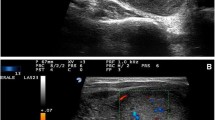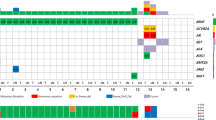Abstract
Carcinomas of the thyroid with Ewing family tumor element (CEFTEs) are small-cell thyroid tumors with epithelial differentiation that disclose p63 expression and EWSR1-FLI1 rearrangement, carry a favorable prognosis and may co-exist with papillary thyroid carcinoma (PTC) foci. Two histogenetic hypotheses have been advanced regarding the origin of CEFTEs: arising in PTCs or in solid cell nests (SCN). A total of 3 CEFTEs, 54 PTCs, and 10 SCNs were reviewed, and fluorescence in situ hybridization (FISH) technique was performed in all cases to search for the presence of EWSR1 rearrangements. The three CEFTEs disclosed the EWSR1-FLI1 rearrangement both in the small cell and in the PTC component. Out of the 54 PTC cases, 28 (51.9%) were positive, 20 (37.0%) were negative, and 6 (11.1%) were inconclusive for EWSR1 rearrangement; in two of the positive PTC cases, the EWSR1-FLI1 rearrangement was detected. Classic PTC disclosed more often the EWSR1 rearrangement than other PTC variants (p = 0.031). PTCs with EWSR1 rearrangement disclosed a lower percentage of nuclei with EWSR1 polysomy than those without EWSR1 rearrangement (p = 0.001). Out of the 10 SCNs, 7 (70.0%) were negative and 3 (30.0%) were inconclusive for the EWSR1 rearrangement. Monosomic nuclei were more frequent (mean of 44.3%) in SCNs than in PTCs (p < 0.001). The presence of the EWSR1-FLI1 rearrangement in PTC component of all studied CEFTEs and the existence of the EWSR1 rearrangement in some PTCs favor the origin of CEFTE from PTC. The high frequency of EWSR1 rearrangements in PTC may represent a new diagnostic marker of these tumors.


Similar content being viewed by others
References
Cruz J, Eloy C, Aragues JM, Vinagre J, Sobrinho-Simões M (2011) Small-cell (basaloid) thyroid carcinoma: a neoplasm with a solid cell nest histogenesis? Int J Surg Pathol 19(5):620–626
Eloy C, Cameselle-Teijeiro JM, Rousseau E, Sobrinho-Simões M (2014) Small cell Tumours of the thyroid gland: a review. Int J Surg Pathol 22(3):197–201
Eloy C, Cameselle-Teijeiro JM, Vieira J, Teixeira MR, Cruz J, Sobrinho-Simões M (2014) Carcinoma of the thyroid with Ewing/PNET family tumor elements: a tumor of unknown histogenesis. Int J Surg Pathol 22(6):579–581
Eloy C, Oliveira M, Vieira J, Teixeira MR, Cruz J, Sobrinho-Simões M (2014) Carcinoma of the thyroid with Ewing family tumor elements and favorable prognosis: report of a second case. Int J Surg Pathol 22(3):260–265
Maldi E, Monga G, Rossi D, Tosoni A, Mezzapelle R, Boldorini R (2012) Extra-osseous Ewing sarcoma of the thyroid gland mimicking lymphoma recurrence: a case report. Pathology – Research and Practice 208:356–359
Jiang Y, Ludwig J, Janku F (2015) Targeted therapies for advanced Ewing sarcoma family tumors. Cancer Treat Rev 41:391–400
Romeo S, Dei Tos AP (2010) Soft tissue tumors associated with EWSR1 translocation. Virchows Arch 456:219–234
Dragoescu E, Jackson-Cook C, Domson G, Massey D, Foster WC (2013) Small cell osteosarcoma with Ewing sarcoma breakpoint region 1 gene rearrangement detected by interphase fluorescence in situ hybridization. Ann Diagn Pathol 17:377–382
Burchill SA (2008) Molecular abnormalities in Ewing’s sarcoma. Expert Rev Anticancer Ther 8:1675–1687
De Alava E, Gerald WL (2000) Molecular biology of the Ewing’s sarcoma/primitive neuroectodermal tumor family. J Clin Oncol 18(1):204–213
Newby R, Rowe D, Paterson L et al (2010) Cryptic EWSR1-FLI1 fusions in Ewing sarcoma: potential pitfalls in the diagnostic use of fluorescence in situ hybridization probes. Cancer Genet Cytogenet 200:60–64
Chan JM, Bilodeau E, Celin S, Nikiforov Y, Johnson JT (2012) Ewing sarcoma of the thyroid: report of 2 cases and review of the literature. Head Neck 35:346–350
Tancredi R, Zambelli A, DaPrada GA et al (2015) Targeting the EWS-FLI1 transcription factor in Ewing sarcoma. Cancer Chemother Pharmacol 75(6):1317–1320
Soares P, Trovisco V, Rocha AS et al (2003) BRAF mutations and RET/PTC rearrangements are alternative events in the etiopathogenesis of PTC. Oncogene 22:4578–4580
Caron NR, Clark OH (2006) Papillary thyroid cancer. Curr Treat Options in Oncol 7:309–319
Soares P, Lima J, Preto A et al (2011) Genetic alterations in poorly differentiated and undifferentiated thyroid carcinomas. Current Genomics 12:609–617
Amacher AM, Goyal B, Lewis JS Jr, El-Mofty SK, Chernock RD (2015) Prevalence of a hobnail pattern in papillary, poorly differentiated and anaplastic thyroid carcinoma: a possible manifestation of high-grade transformation. Am J Surg Pathol 39(2):260–265
Park JH, Kwon HJ, Park CS, Hong SW (2014) Anaplastic transformation of papillary thyroid carcinoma in a young man: a case study with Immnuhistochemical and BRAF analysis. The Korean Journal of Pathology 48:234–240
Sobrinho-Simões M, Preto A, Rocha AS et al (2005) Molecular pathology of well-differentiated thyroid carcinomas. Virchows Arch 447:787–793
Eloy C, Santos J, Soares P, Sobrinho-Simões M (2011) The preeminence of growth pattern and invasiveness and the limited influence of BRAF ans RAS mutations in the occurrence of papillary thyroid carcinoma lymph node metastases. Virchows Arch 459:265–276
Trovisco V, Soares P, Preto A, Castro P, Máximo V, Sobrinho-Simões M (2007) Molecular genetics of papillary thyroid carcinoma – great expectations Arq. Bras Endocrinol Meta 51/5:643–653
Soares P, Fonseca E, Wynford-Thomas D, Sobrinho-Simões M (1998) Sporadic re-rearranged papillary carcinoma of the thyroid: a subset of slow growing, less aggressive thyroid neoplasms? J Pathol 185(1):71–78
Nikiforov YE (2002) RET/PTC rearrangement in thyroid tumors. Endocr Pathol 13:3–16
Lloyd RV, Erickson LA, Casey MB et al (2004) Observer variation in the diagnosis of follicular variant of papillary thyroid carcinoma. Am J Surg Pathol 28:1336–1340
De Vries MM, Celestino R, Castro P et al (2012) RET/PTC rearrangement is prevalente in folicular Hürthle cell carcinomas. Histopathology 61:833–843
Cameselle-Teijeiro J, Abdulkader I, Pérez-Becerra R et al (2009) BRAF mutation in solid cell nest hyperplasia associated with papillary thyroid carcinoma. A precursor lesion? Hum Pathol 40:1029–1035
Reis-Filho JS, Preto A, Soares P, Ricardo S, Cameselle-Teijeiro J, Sobrinho-Simões M (2003) p63 expression in solid cell nests of the thyroid: further evidence for a stem cell origin. Mod Pathol 16(1):43–48
Cameselle-Teijeiro J, Varela-Durán J, Sambade C, Villanueva JP, Varela-Núnez R, Sobrinho-Simões M (1994) Solid cell nests of the thyroid: light microscopy and immunohistochemical profile. Hum Pathol 25:684–693
Park G, Kim TH, Lee HO et al (2015) Standard immunohistochemistry efficiently screens for anaplastic lymphoma kinase rearrangements in differentiated thyroid cancer. Endocr Relat Cancer 22(1):55–63
Chou A, Fraser S, Toon CW et al (2015) A detailed clinicopathologic study of ALK-translocated papillary thyroid carcinoma. Am J Surg Pathol 39(5):652–659
Fallahi P, Mazzi V, Vita R et al (2015) New therapies for dedifferentiated papillary thyroid cancer. Int J Mol Sci 16:6153–6182
Acknowledgments
The authors thank A.Menarini® Diagnósticos Portugal and ZytoVision® for providing the FISH probes and microscope filter for FISH analysis. This work has been partially supported by grant PI15/01501-FEDER to JMC-T from the Instituto de Salud Carlos III, the Ministry of Economy and Competitiveness, Spain.
Authors’ contributions
Oliveira G wrote the manuscript and performed the lab work. Polónia A wrote the manuscript and performed the statistical analysis. Leitão D performed part of the lab work. Cameselle-Teijeiro JM determined the BRAF status of the tumors and revised the manuscript. Sapia S provided external consultation. Sobrinho-Simões M revised the manuscript. Eloy C wrote the manuscript and made the design of the project.
Author information
Authors and Affiliations
Corresponding author
Ethics declarations
Disclosure statement
The authors have nothing to disclose.
Ethics
This work was performed in archived paraffin tissue that remained from the diagnosis of the thyroid samples of patients that were anonymized. The materials used for the work are not needed for diagnosis in the present nor in the future.
Conflict of interest
The authors declare that they have no conflict of interest.
Rights and permissions
About this article
Cite this article
Oliveira, G., Polónia, A., Cameselle-Teijeiro, J.M. et al. EWSR1 rearrangement is a frequent event in papillary thyroid carcinoma and in carcinoma of the thyroid with Ewing family tumor elements (CEFTE). Virchows Arch 470, 517–525 (2017). https://doi.org/10.1007/s00428-017-2095-1
Received:
Revised:
Accepted:
Published:
Issue Date:
DOI: https://doi.org/10.1007/s00428-017-2095-1




